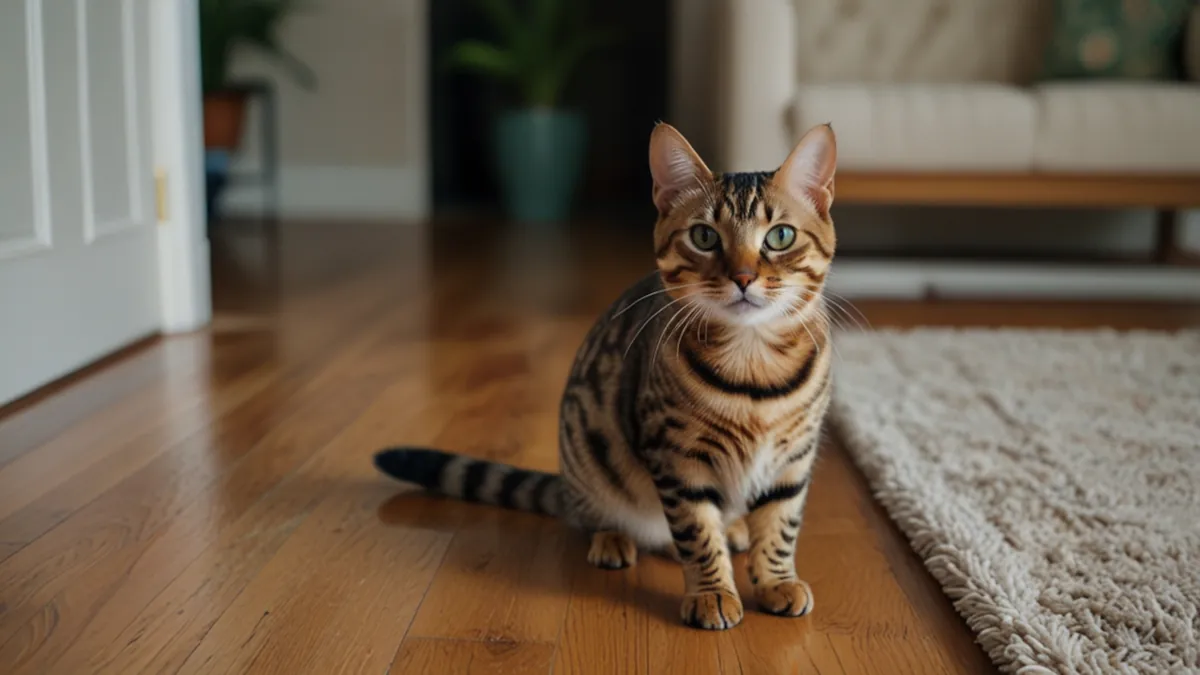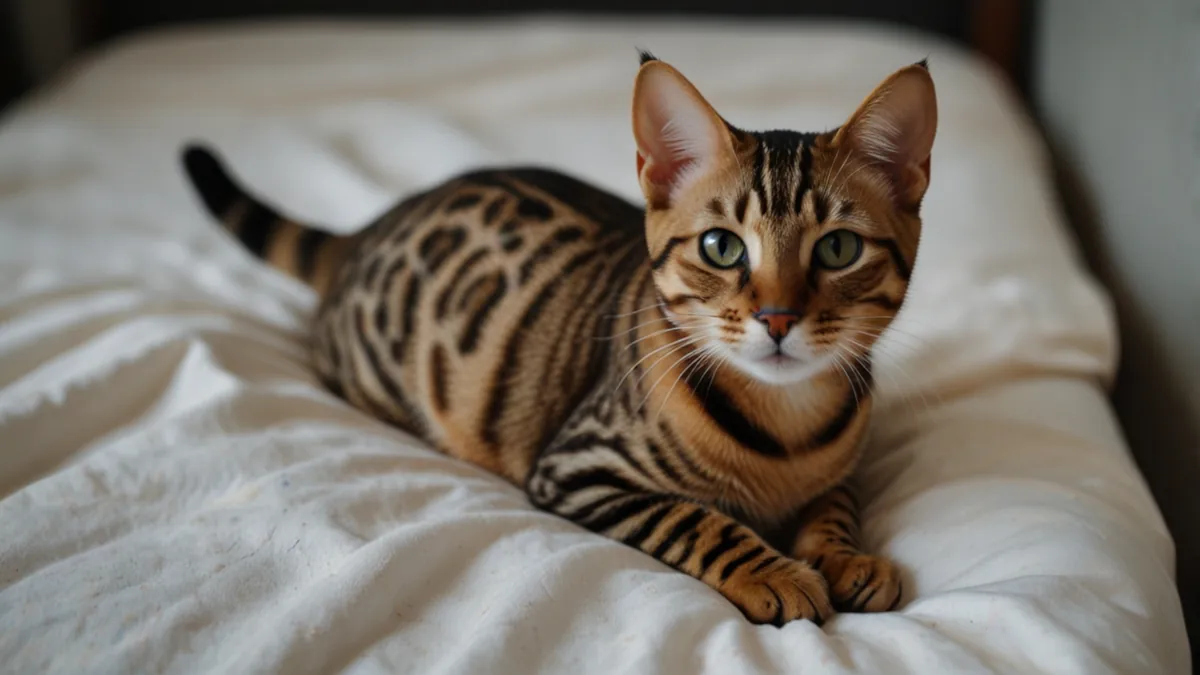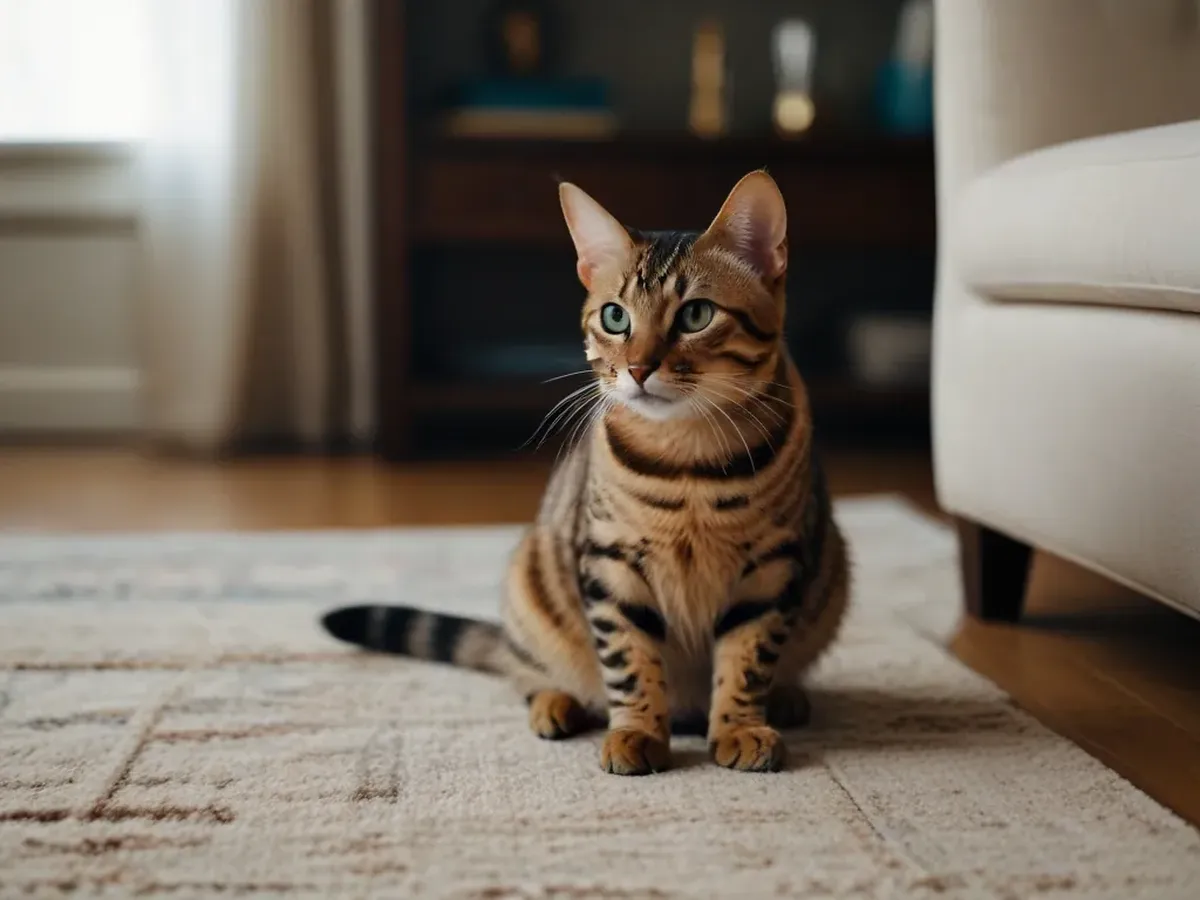In this Guide:
Published: April 16, 2024
Last Updated: March 14, 2025
Bengal Lifespan and Stages
Average Lifespan: With proper care, Bengal cats can enjoy a lifespan of 12-16 years.
Stages of Life and Behaviour:
- Kitten (0-1 year): Bengal kittens are bundles of boundless energy, inheriting their active nature from their wild ancestors. They require plenty of playtime, positive reinforcement training, and opportunities to explore their environment safely.
- Young Adult (1-3 years): While Bengal cats retain their playful spirit throughout their lives, they typically become slightly less energetic as young adults. This is a good time to solidify training and establish routines.
- Adult (3-8 years): Adult Bengals remain active and intelligent. They enjoy interactive games, playtime, and mental stimulation. Positive reinforcement training is key to maintaining a harmonious relationship.
- Senior (8+ years): As Bengals reach their senior years, their activity level may decrease naturally. However, they still appreciate playtime and interaction. Be mindful of any changes in behaviour or mobility that might indicate health concerns.
Colour Variations and Lifespan: The beautiful spotted coat patterns of Bengal cats come in a variety of colours. These variations (brown or black rosettes on gold, snow leoparding with charcoal rosettes on silver, etc.) are purely aesthetic and do not affect a Bengal's lifespan.
Bengal Exercise Needs and Activities
Exercise Requirements:
Bengal cats are highly active and intelligent creatures with a strong prey drive. They require daily exercise and mental stimulation to stay happy and healthy. Aim for at least one hour of dedicated playtime each day, incorporating activities that cater to their natural instincts.
Favourite Activities:
- Climbing: Provide sturdy cat trees and climbing structures to satisfy their love for vertical exploration.
- Interactive Toys: Engage their hunting instincts with feather wands, puzzle feeders, and other interactive toys.
- Leash Training: Some Bengals can be leash trained, allowing for safe outdoor exploration in a controlled environment.
Signs of Insufficient Exercise:
- Destructive Behaviour: Chewing on furniture, scratching inappropriately, or excessive climbing on curtains can all be signs a Bengal is bored and needs more exercise.
- Pacing and Vocalisation: Excessive pacing or vocalisation might indicate pent-up energy and a need for an outlet.
- Weight Gain: Like any other cat, lack of exercise can lead to weight gain in Bengals.
By understanding the unique needs of Bengal cats throughout their lifespan and providing them with ample exercise and mental stimulation, you can ensure a happy and fulfilling life for both you and your feline companion.
Socialisation Needs of Your Bengal
In addition to understanding their lifespan and exercise needs, providing for your Bengal's social, grooming, and training needs is crucial for their well-being and happiness.
Socialisation Needs:
Importance of Socialisation: Bengal cats are social creatures who thrive on interaction with their human companions. Proper socialisation from a young age helps them develop into confident and well-adjusted cats.
Socialisation Techniques:
- Early Exposure: Start socialising your Bengal kitten as early as possible, ideally between the ages of 2-7 weeks. Introduce them to gentle handling, different people (adults and children if applicable), and household noises in a positive and controlled way.
- Positive Reinforcement: Reward your Bengal with treats, praise, and petting during positive interactions. This builds trust and encourages friendly behaviour.
- Playtime: Interactive playtime provides essential bonding experiences and helps your Bengal develop appropriate social skills.
Benefits of Socialisation: A well-socialised Bengal is more likely to be:
- Friendly and affectionate towards humans and other pets (with proper introductions).
- Less stressed in new situations.
- More adaptable to changes in routine.
Remember: Even with proper socialisation, some Bengal cats may be more independent than others. However, socialisation helps ensure they are comfortable interacting with their environment and human companions.
Grooming Needs
While Bengal cats are relatively low-maintenance when it comes to grooming, they do benefit from a regular brushing routine.
- Brushing: Brushing your Bengal 1-2 times a week helps remove loose fur, prevent hairballs, and distribute natural oils throughout their coat to maintain their shine. Use a fine-toothed metal comb or a slicker brush specifically designed for cats.
- Bathing: Unlike some dog breeds, Bengals don't typically require frequent baths. In fact, excessive bathing can strip away their natural oils and irritate their skin. However, an occasional bath (every few months) might be necessary if your Bengal gets particularly dirty.
- Nail Trimming: Regular nail trims (every few weeks) are essential to prevent your Bengal from snagging their nails on furniture or injuring themselves. You can trim their nails yourself using cat nail clippers, or have a veterinarian or groomer perform the task.
- Ear Cleaning: Check your Bengal's ears weekly for any signs of redness, discharge, or odour. Use a gentle ear cleaner recommended by your veterinarian to clean their ears if needed.
- Dental Care: Dental hygiene is crucial for your Bengal's overall health. Provide them with dental chew toys and consider introducing a daily teeth-brushing routine using cat-specific toothpaste.
- Importance of Routine: Establishing a regular grooming routine creates a bonding experience between you and your Bengal. It also allows you to monitor their overall health and identify any potential health concerns early on.
Trainability

Bengal cats are intelligent creatures who can be trained with patience and positive reinforcement. Their active nature often makes them eager to learn new tricks.
- Training Time Commitment: The amount of time required to train your Bengal will vary depending on the specific behaviour you are trying to teach and your cat's individual personality. However, dedicating short, 5-10-minute training sessions daily will yield better results than longer, sporadic sessions.
- Positive Reinforcement Techniques: Reward desired behaviours with treats, praise, or petting. This encourages your Bengal to repeat the positive behaviour and learn new tricks. Avoid punishment or yelling, as this can damage your bond and create negative associations with training.
- Clicker Training: Clicker training can be a helpful tool for Bengal cats. A clicker is a small device that makes a clicking sound. When your Bengal performs the desired behaviour, click the clicker immediately followed by a treat or praise. This creates a clear association between the behaviour, the click, and the reward.
Trainable Behaviours: Here are some examples of behaviours you can train your Bengal for:
- Using a scratching post
- Coming when called
- Sitting or staying
- Walking on a leash (with proper training and harness)
Remember: Be patient and consistent with your training approach. Celebrate even small victories along the way. With patience and positive reinforcement, you can train your Bengal to be a well-behaved and happy companion.
By providing for your Bengal's social, grooming, and training needs, you can create a strong bond with your feline friend and ensure they live a long, happy, and healthy life.
Shedding
Bengal cats are known for their beautiful coat, which is soft, luxurious, and adorned with distinctive rosettes or spots reminiscent of their wild ancestry. When it comes to shedding, Bengals are considered moderate shedders. Their short, dense fur sheds regularly throughout the year, with seasonal fluctuations during spring and fall.
Regular grooming can help manage shedding in Bengal cats. Brushing your Bengal's coat weekly helps remove loose fur and prevents matting. Using a grooming glove or a soft-bristled brush is ideal for this purpose. Additionally, providing your Bengal with a balanced diet rich in omega-3 and omega-6 fatty acids can promote healthy skin and coat, reducing excessive shedding.
It's essential to maintain a clean environment to manage shedding effectively. Regular vacuuming of carpets, upholstery, and other surfaces can help minimise the accumulation of fur around your home.
While Bengal cats do shed, their grooming needs are manageable with proper care and attention, allowing you to enjoy the company of your furry friend without excessive fur-related concerns.
Energy Level

Bengal cats are renowned for their high energy levels and playful nature. As descendants of the Asian Leopard Cat, Bengals retain much of their wild ancestor's active and adventurous traits. These cats thrive on mental and physical stimulation, requiring ample opportunities for exercise and engagement to prevent boredom and behavioural issues.
Owners of Bengal cats should be prepared to provide interactive play sessions, climbing structures, and puzzle toys to keep their feline companions entertained and mentally stimulated. Regular playtime not only helps burn off excess energy but also strengthens the bond between the cat and its owner.
Additionally, Bengals enjoy learning new tricks and participating in agility exercises, making them well-suited for clicker training and positive reinforcement-based training methods. Investing time and effort in training activities can channel their energy into productive outlets while enhancing their cognitive abilities and responsiveness to commands.
While Bengal cats' high energy levels can be demanding, their playful antics and affectionate nature make them delightful companions for owners who are actively involved in their care and enrichment. With proper stimulation and engagement, Bengal cats thrive in loving homes where their energetic personalities are appreciated and embraced.
Temperament
Bengal cats are renowned for their unique temperament, which combines the independence and athleticism of their wild ancestors with the affectionate and sociable traits of domestic felines. These cats are known for their curious nature, intelligence, and playful demeanour, making them engaging companions for devoted owners.
One of the defining characteristics of Bengal cats is their love for interactive play. They enjoy games that involve chasing, pouncing, and climbing, often exhibiting acrobatic feats and agile manoeuvres reminiscent of their wild heritage. Providing Bengal cats with toys, puzzle feeders, and climbing structures allows them to indulge their natural instincts while keeping them mentally and physically stimulated.
Despite their energetic nature, Bengal cats are also affectionate and enjoy spending time with their human family members. They form strong bonds with their owners and often seek out attention and companionship. Bengals are known for their vocalisations, which range from soft chirps and trills to more assertive meows when they want to communicate their needs or desires.
Additionally, Bengal cats are highly intelligent and thrive on mental stimulation. They enjoy learning new tricks, solving puzzles, and engaging in interactive play sessions that challenge their cognitive abilities. Providing environmental enrichment and opportunities for mental exercise is essential for keeping Bengal cats happy and fulfilled.
Bengal cats exhibit a dynamic and multi-faceted temperament that combines athleticism, intelligence, and affection. With proper socialisation, enrichment, and positive reinforcement-based training, Bengal cats make wonderful companions for individuals and families who appreciate their unique qualities and are committed to meeting their needs.
Common Health Concerns
Bengal cats are generally robust and healthy, but like all breeds, they are prone to certain health issues that owners should be aware of. By understanding these common health concerns and taking proactive measures to prevent them, you can help ensure that your Bengal enjoys a long and healthy life.
One of the most prevalent health issues in Bengal cats is hypertrophic cardiomyopathy (HCM), a genetic heart condition that causes thickening of the heart muscle. Regular veterinary check-ups, including cardiac screenings, can help detect HCM early and allow for timely intervention and management.
Another health concern in Bengal cats is progressive retinal atrophy (PRA), a degenerative eye disease that can lead to vision loss over time. Annual eye examinations by a veterinary ophthalmologist can help monitor your Bengal's eye health and detect any signs of PRA or other ocular conditions.
Bengal cats may also be predisposed to certain gastrointestinal issues, such as irritable bowel syndrome (IBS) or food sensitivities. Feeding a high-quality, species-appropriate diet that is free from artificial additives and fillers can help support your Bengal's digestive health and overall well-being.
Additionally, Bengals are known for their love of climbing and exploring, which can put them at risk of falls and injuries. Providing sturdy climbing structures, secure outdoor enclosures, and supervising outdoor adventures can help minimise the risk of accidents and ensure your Bengal's safety.
Regular veterinary care, including vaccinations, parasite prevention, and dental exams, is essential for maintaining your Bengal's health and detecting any potential issues early. Establishing a trusting relationship with your veterinarian and staying proactive about preventive care can help support your Bengal's long-term health and well-being.
While Bengal cats may be predisposed to certain health concerns, proactive veterinary care, a nutritious diet, regular exercise, and a safe environment can help mitigate these risks and promote a long and healthy life for your feline companion.
Costs of Owning a Bengal in the UK
Owning a Bengal cat comes with various expenses, including food, veterinary care, toys, and grooming supplies. Understanding these costs can help you budget effectively and provide the best care for your feline companion.
Food is one of the most significant ongoing expenses associated with Bengal ownership. Bengals are active cats with high energy levels, so they require a balanced diet that provides essential nutrients to support their overall health and well-being. High-quality cat food, whether dry, wet, or raw, can cost anywhere from £20 to £50 per month, depending on the brand and quantity purchased.
Veterinary care is another essential aspect of Bengal ownership. Annual wellness exams, vaccinations, parasite prevention, and dental cleanings are necessary for maintaining your Bengal's health and preventing illness. Veterinary costs can vary depending on your location and the specific services required, but budgeting approximately £200 to £500 per year for routine care is advisable.
In addition to routine veterinary expenses, unexpected medical issues or emergencies can arise, necessitating additional veterinary visits and treatments.
Setting aside funds for unexpected veterinary expenses or investing in pet insurance can help alleviate the financial burden of unexpected medical bills.
Toys and enrichment activities are essential for keeping Bengal cats mentally and physically stimulated. Interactive toys, puzzle feeders, and climbing structures can provide hours of entertainment and prevent boredom and behavioural issues. Budgeting approximately £10 to £30 per month for toys and enrichment activities ensures that your Bengal remains engaged and happy.
Grooming supplies, such as brushes, combs, and nail trimmers, are necessary for maintaining your Bengal's coat and overall grooming needs. While Bengals are generally low-maintenance in terms of grooming, regular brushing helps remove loose fur and prevent matting. Budgeting approximately £10 to £20 for grooming supplies ensures that you have the necessary tools to keep your Bengal looking and feeling their best.
Overall, the costs of owning a Bengal cat can vary depending on factors such as location, lifestyle, and individual needs. By budgeting for food, veterinary care, toys, and grooming supplies, you can provide your Bengal with the care and attention they deserve while managing expenses effectively.
Was this article helpful?



